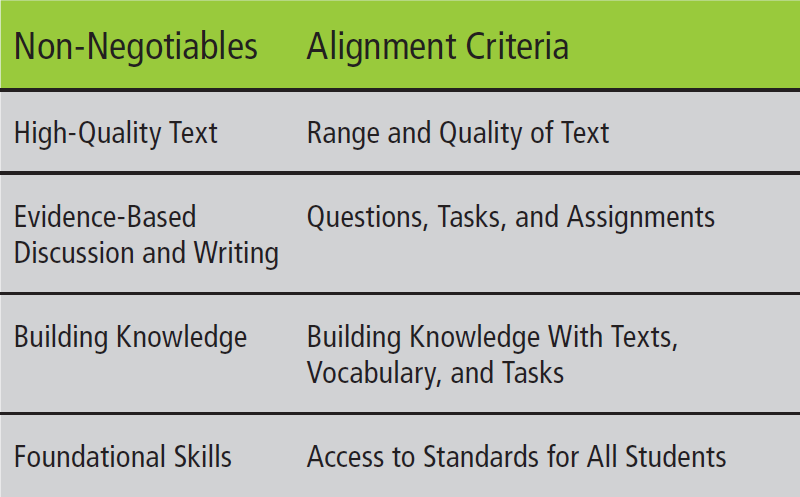Sections / Articles
The Elementary Principal's Guide to Choosing & Evaluating a Literacy Program
Use a simple, step-by-step process to increase educator buy-in.
By Jenny Nauman
Principal, November/December 2017. Vol. 97, Number 2.

Teaching students to learn to read—and, more importantly, to love reading and writing—is one of the most important things we can do as elementary educators. Literacy is a gift and a tool that lasts a lifetime and helps our students become better people both academically and socially. Dr. Seuss said it best: “The more that you read, the more things that you will know. The more you learn, the more places you’ll go!”
Given reading’s importance, we have a responsibility to ensure that our literacy programs and instruction are top-notch. Choosing a new literacy program can be time-consuming and laborious, but the results can create a culture of learners who love to read. Here’s how to make this happen in your school or district.
Evaluate Your Current Literacy Program
With the implementation of the Every Student Succeeds Act (ESSA) underway, literacy instruction is at the forefront. The law requires that all students be taught to high academic standards to ensure that they are college and career ready. Many districts, including ours, began to look at current literacy programs to determine whether they were rigorous enough to meet students’ needs. The following is a process to help with an evaluation:
1. Create a team of stakeholders.
The team should include grade-level teacher representatives (some who are open to change and others who are not), school-level administration, district-level administration, and parents.
Together, the team will evaluate your current program. If the team of stakeholders determines that a new program is necessary, that decision is more likely to be accepted than if a new program is imposed on the district by an administrator.

2. Use a tool to evaluate your current materials.
It is important to look at your program systematically. One way to evaluate your current program is to use the Instructional Materials Evaluation Tool (IMET) to look at four non-negotiables and four alignment criteria outlined in the table above.
3. Determine whether a change is needed.
When using the IMET or any other tool, you can determine whether the program meets your criteria for a quality program. Together, determine whether it is time to start looking for a new literacy program.
4. Communicate the change.
Lastly, communicate the need to change to all stakeholders. It’s especially important to ensure that your district office and school board will support adoption of a new program.
Choosing a Literacy Program
The fun—and hard work—begins after the team has decided a new program is needed. New literacy programs can be very expensive, so it is important to choose wisely. Start with these guiding questions: What does your school or district believe about literacy instruction? What’s your goal for the students? How open is your current staff to change and professional development?
Once you answer those questions, you can start looking at programs that are research-based and allow for choice and voice for students. Include authentic texts. Facilitate discourse. Help to provide access to the standards for all (differentiation). Work with a balanced literacy approach. Have embedded, ongoing professional development and coaching. Instill a love of reading in students.
The one absolute non-negotiable is to determine whether the program allows you to empower your students through independent, self-selected reading, as this is the single biggest predictor of student literacy success. Unfortunately, most students across the country spend only 10–15 minutes per day reading. By making independent reading fun and purposeful, and encouraging students to read 30 minutes during school and 30 minutes at home each day, we can create a culture of students and parents who love reading.
Have a small team of stakeholders narrow down the search to just a few programs that meet the above criteria; choosing at least three and no more than five is most beneficial.
Next, use a process similar to the one you used when you evaluated your current program to whittle down your choices:
1. Create or reconvene the team of stakeholders.
Involving stakeholders in this process will facilitate teacher and parent buy-in when a decision is made. You may want to keep your original team and add a few additional people, or you can completely revamp the entire team. Be sure the team includes a variety of stakeholders who are respected by their peers and represent different experience levels and expertise.
2. Have the reps from the final companies come and do presentations.
Invite representatives from each company to present to your team or the greater school community. The representatives will give you detailed information about the programs and answer any questions the team might have.
3. Evaluate the program based on your school and district needs.
Look at each program objectively using the IMET to help quantify your thoughts. Also, look at each program anecdotally to see how it will fit into your district philosophy and your goal for students. Narrow your focus down to two or three programs.
4. Have teachers pilot materials from each viable program.
Choose teachers or ask for volunteers to implement, with fidelity, a unit or two of a program. It is best, but not always feasible, to have the same teachers try out all of the programs so they can determine the pros and cons of each. The teachers should focus on the instructional design of the program, the content (what is taught), and the pedagogy (how it is taught). If neighboring districts are implementing the program, have the team visit to see the program in action.
5. Take your time, and meet frequently.
It is important to have great discourse among your stakeholder team, but also with your school community. As this process is unfolding, make sure that the pilot teachers are talking with each other, and that there is a way for them to share progress with other teachers throughout the school or district. Ensure that these conversations happen frequently and that you take your time to make the right decision for your organization.
6. Make your decision, and ask for funding.
Choosing the right program should be based on consensus. It is not likely that you will get everyone to agree, but the majority should agree on this huge decision. Once you have chosen the perfect literacy program for your school or district, getting the funding may be the trickiest part. In our district, this type of decision has to be board-approved. Have your stakeholder team create a wonderful presentation about the program and its strengths to share with the board.
7. Communicate the adoption to all.
Once the funding is in place, communicate the decision to all stakeholders to build excitement. Students, parents, teachers, and support staff should be made aware of the planned changes. Spread excitement about the new venture.
Implementing a New Literacy Program
Implement the program with as much fidelity as possible. Collect all previously used curriculum materials so teachers can’t fall back on what they already know.
Set clear expectations for implementation, and monitor those expectations closely. Make your school schedule conducive to the program chosen.
Schedule professional development (PD) sessions so teachers can learn how to implement the program. PD should not be a one-time event; an ongoing coaching model is more effective and helps teachers feel supported.
Keep parents involved and informed. A new program can bring about changes in assessments, grading, expectations, and homework. Parents want to understand the “why” of what we are doing.
Listen to and support your teachers. Provide them time to collaborate and have meaningful discourse.
Never take your eye off the prize: a school community that fosters the love of reading! At Shields Elementary in Cape Henlopen School District, we just recently went through the above process to choose a new literacy program, the American Reading Company’s Balanced Literacy System. Teachers were active participants in the process and are looking forward to allowing students both choice and voice as they develop their literacy skills. As a reading specialist by heart and by trade, I am excited that our students will have the opportunity to experience reading in 120-minute literacy blocks. Good luck in creating a culture in which reading is valued and students discover the love of a good book!
Jenny Nauman is principal of Shields Elementary School in Lewes, Delaware.
Copyright © National Association of Elementary School Principals. No part of the articles in NAESP magazines, newsletters, or website may be reproduced in any medium without the permission of the National Association of Elementary School Principals. For more information, view NAESP's reprint policy.
| Attachment | Size |
|---|---|
| Nauman_ND17.pdf | 2.08 MB |